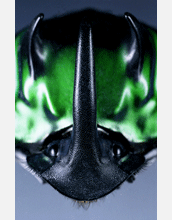Multimedia Gallery
Scarab Dung Beetle
A very close view of the head horns on a male South American scarab dung beetle, Oxysternon conspicillatum. This beetle species is trimorphic, meaning they are able to produce up to three different types of males, with different forms of 'weaponry' for use when competing for a mate. This particular specimen has very large head horns, which indicates it is an alpha male. Beta males have disproportionally smaller horns and gamma males and females have no head horns at all.
More about this Image
Like many species of animals that produce enlarged 'weapons' that function in male combat when competing for a mate--such as horns on dinosaurs, antlers on deer and tusks on elephants and walrus--these elaborate male weapons are also known to occur in many types of insects.
While working on National Science Foundation (NSF)-supported research on the evolution of male dimorphism in insects, J. Mark Rowland of the University of New Mexico and Douglas J. Emlen of the University of Montana discovered that many species of beetles are trimorphic, meaning they are able to produce up to three different types of males, with different forms of weaponry.
Rowland and Emlen discovered a mating system where individual males of these trimorphic species of beetles have the capacity to express one of three alternative morphologies: alpha (possessing large head horns), beta (possessing disproportionally smaller head horns) and gamma (completely hornless, like the females of the species). "In many dung beetles," said Rowland, "smaller males are unlikely to prevail in direct contests with disproportionally smaller horns, and employ alternative, less aggressive reproductive tactics."
Research initially focused on male trimorphism in dung beetles but later expanded to include other families of beetles that were also trimorphic and had weapon systems, including mandibles in stag beetles and ventral spines in weevils. The researchers also discovered that with these trimorphic species, the male taking the gamma (hornless) form is always female-like in morphology. This may be a tactic employed by nature to deceive and evade combat, but still earn a sexual encounter.
Though extremely rare, trimorphism is known to exist in other animal species, but the three forms are determined by genetics. Male trimorphism in beetles, however, appears to be facultative in nature, meaning the different forms of males are expressed by individuals not according to genetics, but according to the specific environmental conditions they encounter. [Research supported by NSF grant IOS 06-42409.] (Date of Image: 2008)
Credit: J.M. Rowland and D.J. Emlen
Images and other media in the National Science Foundation Multimedia Gallery are available for use in print and electronic material by NSF employees, members of the media, university staff, teachers and the general public. All media in the gallery are intended for personal, educational and nonprofit/non-commercial use only.
Images credited to the National Science Foundation, a federal agency, are in the public domain. The images were created by employees of the United States Government as part of their official duties or prepared by contractors as "works for hire" for NSF. You may freely use NSF-credited images and, at your discretion, credit NSF with a "Courtesy: National Science Foundation" notation.
Additional information about general usage can be found in Conditions.
Also Available:
Download the high-resolution JPG version of the image. (2.3 MB)
Use your mouse to right-click (Mac users may need to Ctrl-click) the link above and choose the option that will save the file or target to your computer.

